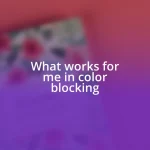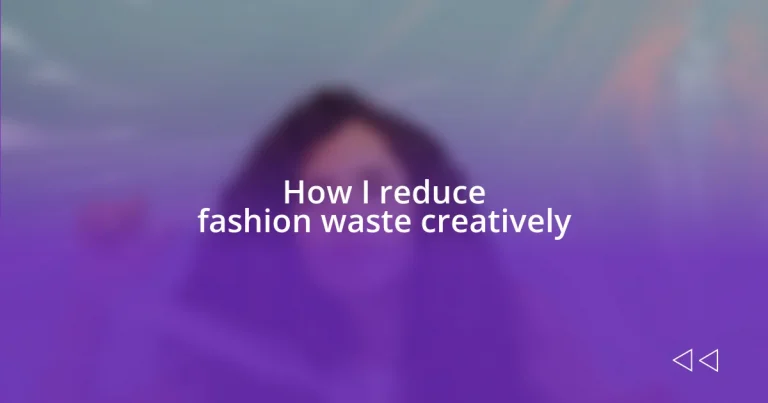Key takeaways:
- Upcycling techniques like transforming t-shirts into tote bags and revamping damaged clothing, such as jeans into shorts, promote sustainability and creativity in fashion.
- Exploring sustainable fabric alternatives like organic cotton, Tencel, and recycled polyester enhances wardrobe choices while reducing environmental impact.
- Participating in local clothing swaps and sharing creative journeys online fosters community connection, accountability, and inspires others towards sustainable practices.
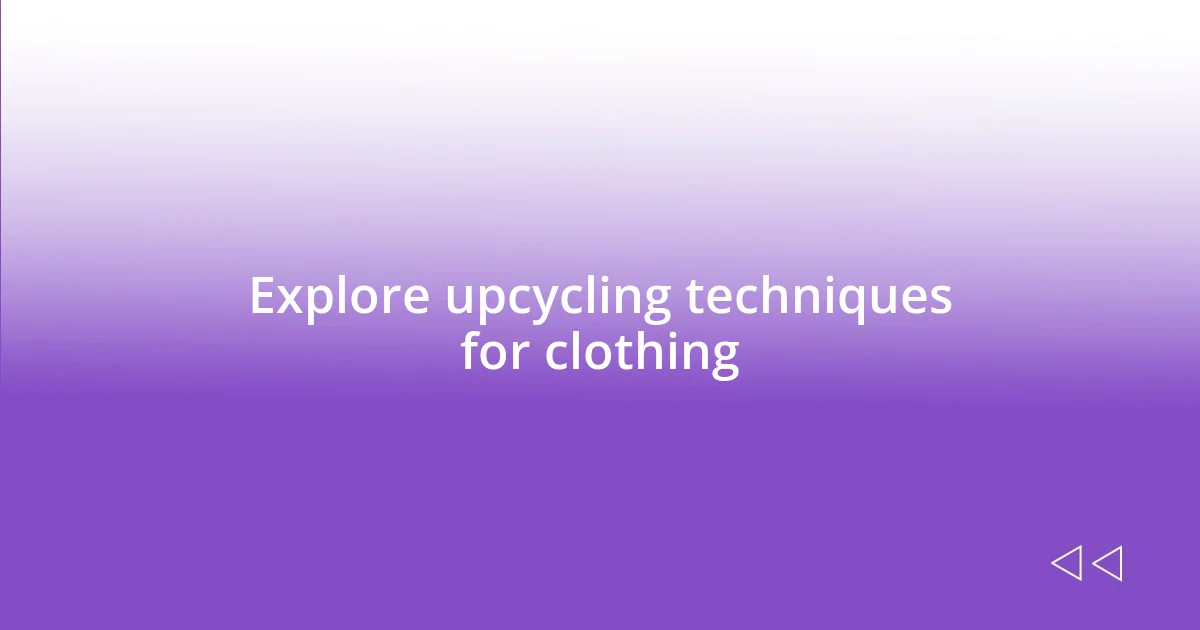
Explore upcycling techniques for clothing
One of my favorite upcycling techniques has been transforming old t-shirts into tote bags. It’s a simple project that not only gives new life to worn-out clothing but also reduces my need for plastic bags. Have you ever considered the joy of carrying a bag that tells a story—maybe from a concert or a cherished memory?
Another technique involves taking a beloved but damaged piece, like a pair of jeans with frayed hems, and turning it into stylish shorts. I remember a pair of jeans that I thought I’d never wear again, but after a little snipping and sewing, they became my go-to summer staple. Isn’t it fascinating how a small change can rejuvenate an item that once felt like junk?
I’ve also experimented with dyeing techniques, such as using natural dyes from kitchen scraps. The first time I dyed a white shirt with avocado pits, I was amazed at the soft pink hue that emerged. It not only felt rewarding to repurpose waste but also gave my clothing a unique twist that no store-bought item could replicate. How do you think embracing these creative methods can change our perspective on fashion waste?

Learn to revamp old accessories
Revamping old accessories offers a unique opportunity for self-expression and sustainability. For instance, I once had a beautiful leather handbag that had seen better days – it was scuffed and losing its luster. Instead of tossing it, I decided to give it a makeover by adding some bold fabric patches and decorative studs. The transformation was so satisfying; it felt like I was carrying a piece of art that reflected my personality. Have you ever thought about how much personality your accessories can hold when you decide to update them?
A few creative ideas to revamp your old accessories include:
– Embellishing a plain belt with fabric flowers or metallic studs to make it pop.
– Transforming old scarves into headbands, bracelets, or even bag straps for a fresh twist.
– Using jewelry findings to turn broken necklaces into trendy layered looks or minimalist earrings.
– Repainting old bangles or wooden earrings with vibrant colors to match your current style.
– Incorporating vintage brooches into hairpins or hats, giving them a charming, nostalgic vibe.
Every small change can breathe new life into something I thought was forgotten. What would you create from your dust-collecting accessories?
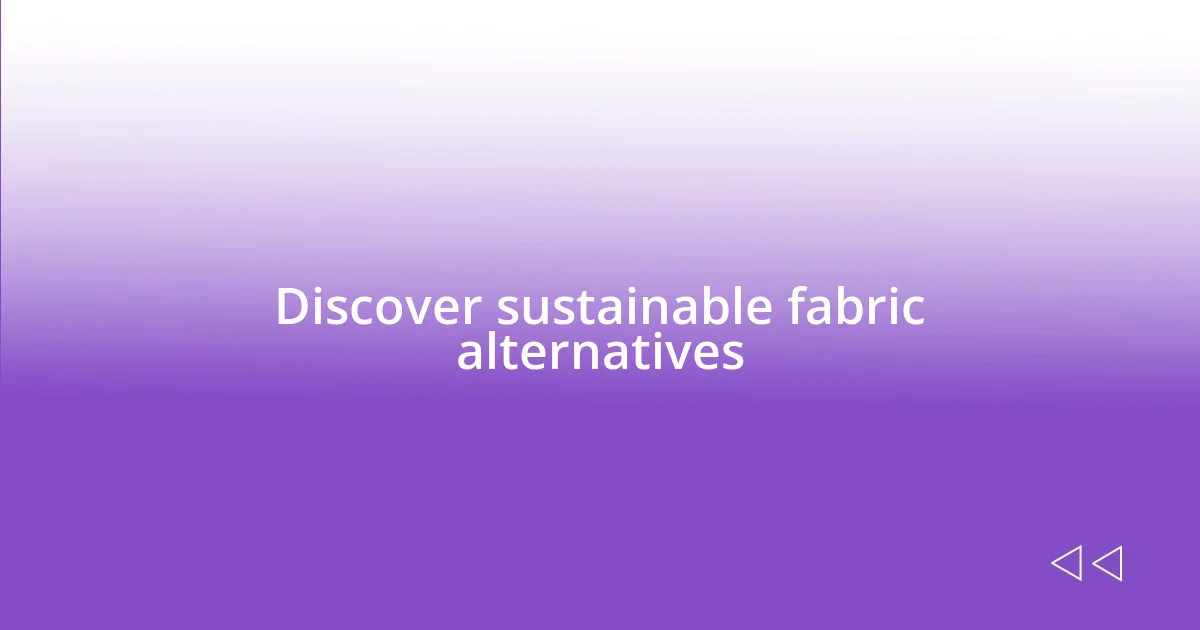
Discover sustainable fabric alternatives
| Sustainable Fabric | Key Benefits |
|---|---|
| Organic Cotton | Grown without synthetic pesticides, organic cotton is soft, breathable, and biodegradable, making it a safer choice for both you and the planet. |
| Tencel (Lyocell) | Made from sustainably sourced wood pulp, Tencel is incredibly soft, durable, and requires less water to produce compared to traditional fabrics. |
| Recycled Polyester | Utilizes plastic waste, such as bottles, reducing landfill contributions and energy usage in fabric production. |
| Hemp | Resilient and resistant to pests, hemp requires minimal water and no chemical fertilizers, making it an eco-friendly textile option. |
Experimenting with sustainable fabric alternatives has genuinely enhanced my wardrobe while also reducing my environmental footprint. I’ve discovered that organic cotton, for example, offers a comfort level that traditional cotton can’t match. When I first wore an organic cotton tee, I remember feeling the difference in texture—not only was it soft, but I felt good knowing it was grown responsibly. Isn’t it amazing how our choices can be both stylish and sustainable?
I’ve found Tencel to be another game changer. It’s incredible to wear something not only luxurious but also sustainably produced from wood pulp. The first time I bought a Tencel dress, I was awestruck by how it draped effortlessly on me, giving that “silk-like” feel without the guilt of harming the environment. Have you experienced that bliss of wearing a fabric that feels like a hug?
Recycled polyester is also quite fascinating. Using reclaimed plastic bottles to create clothing struck me as an innovative solution to a pressing problem. I recently wore a jacket made from recycled materials while out on a hike, and it made me feel empowered—like my wardrobe was contributing to a bigger fight against pollution. How profound is it that what we wear can reflect our values?
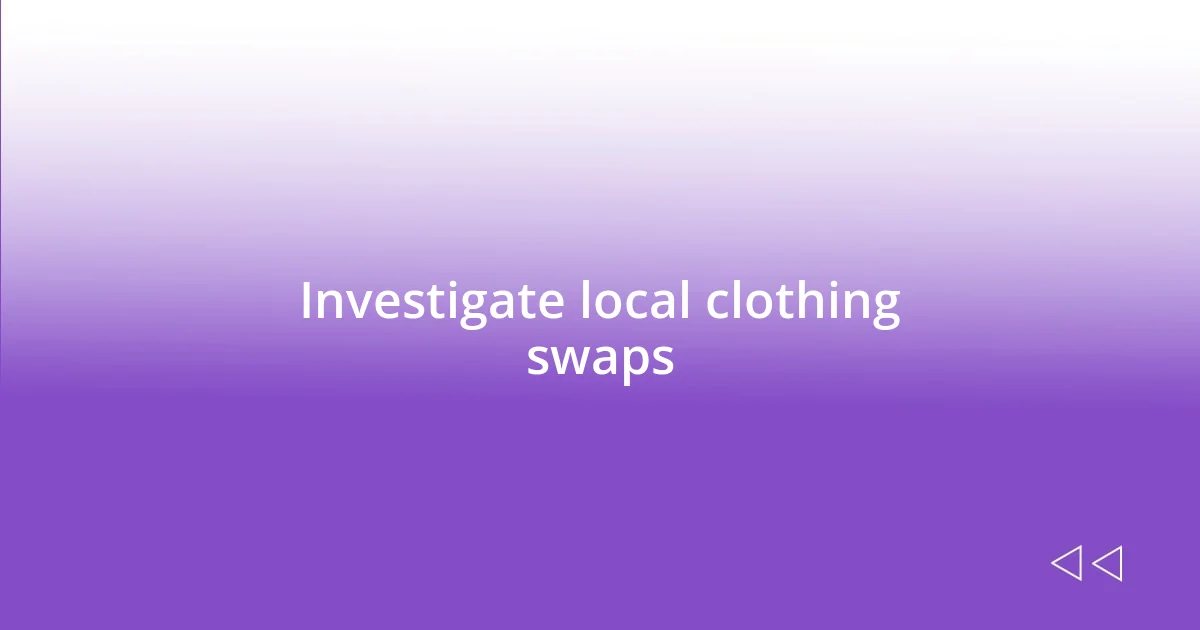
Investigate local clothing swaps
Investigating local clothing swaps can be a delightful way to refresh your wardrobe while connecting with your community. I remember attending my first swap; it felt like a treasure hunt filled with unexpected finds and conversations. As I rummaged through the racks, I stumbled upon a vintage denim jacket that instantly caught my eye. Isn’t it exhilarating to find something unique that someone else no longer wants, yet it feels like it was custom-made for you?
These events not only contribute to sustainable fashion, but they also foster a sense of camaraderie among participants. I’ve met some amazing people at clothing swaps who have become friends, bonded by our shared goal of reducing waste. The stories behind each item often add a sentimental touch—like when I swapped a pair of shoes I loved but couldn’t fit anymore and exchanged them for a stunning dress that came with a sweet backstory about the seller’s travels. Have you ever felt that your clothing choices are intertwined with the experiences of others?
Moreover, clothing swaps can introduce you to diverse styles and ideas. I recall spotting a unique tie-dye shirt that I might never have considered buying on my own. Trying it on was a game-changer; it made me realize how expanding my comfort zone can lead to new favorite pieces. Wouldn’t you agree that discovering new wardrobe possibilities in such an unconventional way can be an empowering experience?

Find tips for mindful shopping
Finding tips for mindful shopping is truly about tuning into our habits and choices. I always start by creating a shopping list before I head out, which keeps me focused and prevents impulse buys. There was a time I wandered aimlessly through stores—temptation always led me to buy things I didn’t need. Now, that intentional approach saves me money and clutter. Isn’t it refreshing to realize how little effort can lead to such big changes?
I also make it a point to pause and ask myself if I really love an item before purchasing. This reflection has changed my entire shopping mindset. I once found myself captivated by a trendy blouse, but after some thought, I realized it didn’t align with my personal style. Walking away felt empowering; it was a small win in my mindful shopping journey. Have you ever had that moment of clarity that made you rethink a potential purchase?
Lastly, I pay attention to brands’ sustainability practices. I vividly remember discovering a small, eco-friendly brand that sources materials ethically. Each piece I bought felt like a small step toward making conscious choices, and I proudly wear their creations knowing they align with my values. It’s rewarding to support brands that are committed to making a difference, isn’t it? By shifting our focus and being more discerning, we can turn shopping into a mindful activity that benefits both us and the environment.

Share your creative journey online
Sharing your creative journey online can be such a fulfilling experience. I started documenting my fashion projects on social media, and to my surprise, it created a wonderful connection with others who share a similar passion for sustainability. I remember posting a video of me transforming an old t-shirt into a trendy bag. The feedback was incredible! Have you ever thought about how your unique journey could inspire someone else to think differently about their wardrobe?
As I continued to share, I discovered an entire community of like-minded individuals. We exchange tips, discuss projects, and celebrate each other’s successes. I once participated in a virtual DIY challenge, and seeing so many people transform items in their own unique styles gave me such a rush of creativity. It’s fascinating how sharing your journey can foster collaboration and spark new ideas. Have you ever felt that sense of excitement when your work resonates with others?
Additionally, I’ve found that sharing my journey encourages accountability. When I post my goals or upcoming projects, it motivates me to follow through. For example, I announced a commitment to upcycling one piece of clothing each month. The thrill of showcasing those creations pushed me to explore techniques I’d never tried before. It’s amazing how being part of an online space can drive you to stay focused and committed to reducing waste creatively. Have you considered how sharing your own journey might keep you motivated in your pursuits?

